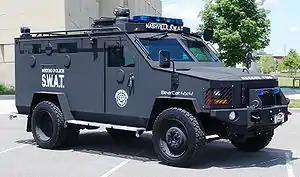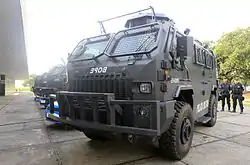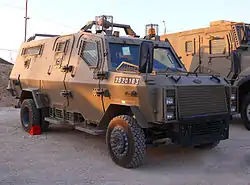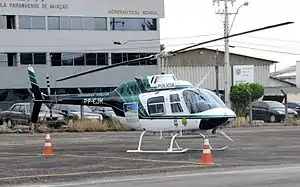Military Police (Brazil)
Military Police (Portuguese: Polícia Militar, IPA: [puˈlisjɐ miliˈtaʁ], also known as PM, [peˈẽmi]) are the preventive state police of the states and of the Federal District of Brazil. The Military Police units, which have their own formations, rules and uniforms depending on the state and the Federal District, are responsible for ostensive policing and the maintenance of public order. Detective work and forensics are undertaken by a state's Civil Police.
| Military Police Polícia Militar | |
|---|---|
 Insignia of the Military Police used since 1957.[3] | |
| Abbreviation | PM |
| Agency overview | |
| Formed | 1809 |
| Employees | 450,000 active personnel[4] |
| Jurisdictional structure | |
| Operations jurisdiction | Brazil |
| General nature | |
| Operational structure | |
| Agency executive |
|
| Parent agency | Military Reserve Force of Brazilian Army |
| Notables | |
| Person |
|
| Significant operation |
|
| Anniversary |
|
All state Military Police and Military Firefighters Corps are classed as reserve troops and ancillary forces of the Brazilian Army.[5] In time of war (or other emergencies) the military police forces can be pressed into federal service. But they remain distinct from the provosts belonging to the other services within the Brazilian Military: the corps Army Police (Portuguese: Polícia do Exército, PE) for the Army, Police Company of the Naval Battalion (Companhia de Polícia do Batalhão Naval) for the Navy, and Air Force Police (Portuguese: Polícia da Aeronáutica, PA) for the Air Force.
In 2004 the National Public Security Force (Portuguese: Força Nacional de Segurança Pública) was created to handle any significant security crisis. The unit, which is composed of the most qualified Military Police personnel from all federal states, can only be deployed through the express command of a state governor.
History
The first militarized police in Portugal (when Brazil was still a colony) was the Royal Police Guard of Lisbon (Portuguese: Guarda Real de Polícia de Lisboa), established in 1801;[6] which was followed by the model of the National Gendarmerie (French: Gendarmerie Nationale) of France, created in 1791.
When the Portuguese Royal Family was transferred to Brazil, the Royal Police Guard of Lisbon remained in Portugal, and another equivalent was created in Rio de Janeiro, under the name of Military Division of the Royal Guard Police of Rio de Janeiro, in 1809.[7]
With the abdication of Emperor Pedro I in 1831, the Regency held reformulations on the Brazilian Armed Forces. The Royal Guard Police of Rio de Janeiro was abolished,[8] and replaced by the Municipal Guard Corps of Volunteers;[9] a type of security force similar to the French National Guard. The same law allowed each province to establish its own Guard of Volunteers.
In 1834 Pedro I died in Portugal and this reduced the fear in Brazil of a reunification of the kingdoms. The Guard of Volunteers were then transformed into Province Police Corps, with professional troops.[10] The Police Corps were created with the same structure as the Army, and to serve as reserve troops when necessary.
With the Proclamation of the Republic, Brazil adopted a constitution based on the United States' one, where the federal states have a large amount of autonomy. The Corps of Police began to be administered by the states and became smaller regional armies, with infantry, cavalry, artillery, and later, even air forces. This danger to national security remained until the end of World War II, with the deposition of the dictatorial government of Getúlio Vargas.
After World War II, the Military Police assumed the roles of a more "traditional" police force, similar to a gendarmerie subject to the states.[11] It sought a rapprochement with the civil society, slowly developing the configuration it currently possesses.
Structure

Organization
The Secretariat for Public Security (Secretaria de Segurança Pública—SSP) supervises all state police activities.[12] The SSPs are subordinate to the National Council of Public Security (Conselho Nacional de Segurança Pública - CONASP).[12]
According to Article 144 of the federal constitution, the function of the Military Police "is to serve as a conspicuous police force and to preserve public order."[12] The Military Police of any state are organized as a military force and have a military-based rank structure.[12] Training is weighted more heavily toward police matters, but counterinsurgency training is also included.[12] Arms and equipment of state forces include machine guns and armored cars, in addition to other items generally associated with police.[12]
Article 144 of the constitution stipulates that: "The Military Police forces and the Military Firefighters Corps, ancillary forces and army reserve, are subordinate, along with the Civil Police forces, to the governors of the states, Federal District, and territories."[12] Between 1969 and 1985, the Ministry of Army has controlled the Military Police during periods of declared national emergency.[12] Before 1930 these forces were under individual state control, and known as "the governors' armies." They sometimes outnumbered regular troops in many states.[12] In 1932, after Constitutionalist Revolution in São Paulo, the Federal Army took steps to reverse this situation. In 1964 most Military Police members were on the side of the successful conspirators.[12]

During military dictatorship, Military Police units were often commanded by active-duty army officers, but that has occurred less frequently as professional police officers have achieved higher ranks and positions.[12] The commandant of a state's Military Police is usually a Colonel.[12] The command is divided into police regions, which deploy police battalions and companies.[12] Firefighting is also a Military Police function[12] in some states, but they are organized in separate units called Corpo de Bombeiros Militar.[12] State traffic police are either the State Highway Police (Polícia Rodoviária Estadual), or the Traffic Police (Polícia de Trânsito) in the larger cities.[12] Both are part of the state Military Police.[12]
Field organization
The Military Police is organized into battalions (Portuguese: Batalhão de Polícia Militar), companies (Portuguese: Companhia de Polícia Militar), platoons (Portuguese: Pelotão de Polícia Militar), and subdivided into detachments (Portuguese: Destacamento de Polícia Militar). The battalions are based in major urban centers, and their companies and platoons are distributed according to population density in cities.
The mounted police is organized into regiments (Portuguese: Regimento de Polícia Montada), subdivided into squadrons (Portuguese: Esquadrão de Polícia Montada) and platoons of mounted police.
Nomenclature
Throughout Brazil the Military Police is known by the acronym PM (for Policia Militar), followed by the abbreviation of the State. Except in the State of Rio Grande do Sul, where the unit is known as BM, (for Brigada Militar, "Military Brigade").

- 01 . PMAC - Acre
- 02 . PMAL - Alagoas
- 03 . PMAP - Amapá
- 04 . PMAM - Amazonas
- 05 . PMBA - Bahia
- 06 . PMCE - Ceará
- 07 . PMDF - Distrito Federal
- 08 . PMES - Espírito Santo
- 09 . PMGO - Goiás
- 10 . PMMA - Maranhão
- 11 . PMMT - Mato Grosso
- 12 . PMMS - Mato Grosso do Sul
- 13 . PMMG - Minas Gerais
- 14 . PMPA - Pará
- 15 . PMPB - Paraíba
- 16 . PMPR - Paraná
- 17 . PMPE - Pernambuco
- 18 . PMPI - Piauí
- 19 . PMERJ -Rio de Janeiro
- 20 . PMRN - Rio Grande do Norte
- 21 . BMRS - Rio Grande do Sul
- 22 . PMRO - Rondônia
- 23 . PMRR - Roraima
- 24 . PMSC - Santa Catarina
- 25 . PMESP- São Paulo
- 26 . PMSE - Sergipe
- 27 . PMTO - Tocantins
These forces are distinct from the three provost forces that police the Brazilian armed forces: The Naval Battalion Police Company (Portuguese: Companhia de Polícia do Batalhão Naval), Army Police (Portuguese: Polícia do Exército), and Aeronautical Police (Portuguese: Polícia da Aeronáutica)
Uniforms

The Brazilian Armed Forces inherited Portuguese military traditions and during the period of the Empire and part of the Republic, with few exceptions, dark blue uniforms were used. In 1903 the Brazilian Army opted for khaki colored field uniforms, later copied by the Military Police. In 1934 the Ministry of War established khaki as the color khaki for all reserve forces.
After the Second World War, the Military Police had the autonomy to adopt its own uniforms, but most stayed with the khaki. During the Military Government in 1976, the Army suggested that the Military Police adopt the blue color (color of the uniform of the Military Police of the Federal District). Since then, some units have changed their uniforms while others have not.
Currently the color khaki (with variations to beige) and blue (with variations of gray to dark blue) prevail in the colors of the uniforms of the Military Police.
- Forces with khaki uniforms (includes green)
- Forces with blue uniforms (includes Blue-grey)
This applies only to service uniforms, not to the formal uniform, which has different variations.
Ranks
The Military Police of the Brazilian States have almost the same hierarchical ranking system[13] of the Brazilian Army, but with different insignias and with no rank of "general".
- Officers
| Equivalent NATO Code | OF-10 | OF-9 | OF-8 | OF-7 | OF-6 | OF-5 | OF-4 | OF-3 | OF-2 | OF-1 | OF(D) & Student officer | |||||||||||||||||||||||||
|---|---|---|---|---|---|---|---|---|---|---|---|---|---|---|---|---|---|---|---|---|---|---|---|---|---|---|---|---|---|---|---|---|---|---|---|---|
| No equivalent |
 |
 |
 |
 |
 |
 |
 |
 |
.svg.png.webp) |
|||||||||||||||||||||||||||
| Comandante geral | Comandante adjunto | Coronel | Tenente-coronel | Major | Capitão | Primeiro tenente | Segundo tenente | Aspirante | Aulno 3° ano | Aulno 2° ano | Aulno 1° ano | |||||||||||||||||||||||||
- Enlisted
| Equivalent NATO code | OR-9 | OR-8 | OR-7 | OR-6 | OR-5 | OR-4 | OR-3 | OR-2 | OR-1 | |||||||||||||||||||||||||||
|---|---|---|---|---|---|---|---|---|---|---|---|---|---|---|---|---|---|---|---|---|---|---|---|---|---|---|---|---|---|---|---|---|---|---|---|---|
 |
No equivalent |  |
 |
 |
 |
No equivalent | ||||||||||||||||||||||||||||||
| Subtenente (Warrant Officer) |
Primeiro-sargento | Segundo-sargento | Terceiro-sargento | Cabo | Soldado primeira classe |
Soldado segunda classe | ||||||||||||||||||||||||||||||
Main types of policing
Ratio of Military Police to Population
Analysis by the Federal Government of the ratio of resident population to the number of official Military Police in 2003 shows that the proportion is quite varied among the states. The states of Roraima, Amapá, Acre, Rondônia, Rio Grande do Norte and Rio de Janeiro, plus the Federal District have a higher proportion of Military Police. In the Federal District, for example, for each military police there are one hundred and thirty-seven inhabitants.
At the opposite extreme, the states with the lowest ratio of military police are Pará, Maranhão, Piauí, Ceará, Mato Grosso do Sul, Paraná and Rio Grande do Sul. Maranhão has the lowest, with eight hundred and twenty-two people per Military Police.
Note that in the case of São Paulo and Paraná the numbers of the Military Firefighters Corps are included in the figures for Military Police.[14]
National Public Security Force


In situations of serious disturbance of public order that exceeds the capacity of the States, their Governors can request assistance from the Federal Government.
To work in such situations, the Ministry of Justice has the National Public Security Force (Portuguese: Força Nacional de Segurança Pública; FNSP), a national gendarmeire composed of selected MP personnel and constables from state military police commands.
The FNSP is composed of specially trained officers and other ranks of the Military Police of different States, in coordination between the Secretary of Public Safety of each State and the Ministry of Justice.
Inspectorate General of Military Police

The Inspectorate General of Military Police (Portuguese: Inspetoria Geral das Polícias Militares) - IGPM is a command element of the Brazilian Army, responsible for coordinating and conducting activities of control over the Military Police and Military Firefighters Corps of States.[15]
It is part of the Land Operations Command (Portuguese: Comando de Operações Terrestres) - COTER and its mission is:
- The establishment of principles, guidelines and standards for the effective implementation of control and coordination of the Military Police under Command of the Army, through its Military Area Commands, Regions and other Major Military Command;
- The control of the organization and legislation, personnel and equipment of military police, such as:
- Weapons, ammunition, communications equipment, chemical agents, military equipment, vehicles, aircraft and boats.
- Collaboration in studies aiming to rights, justice and guarantees of the Military Police, and the establishment of conditions for convening and mobilization;
- Coordinating and monitoring compliance with the provisions of relevant State and Federal Legislation;
- Conduct regular inspections.
Equipment
Armored vehicles
| Name | Origin | Type | Quantity | Used by | Note | Photo |
|---|---|---|---|---|---|---|
| Lenco BearCat | Law enforcement vehicle | 1 | Ordered |  | ||
| Paramount Group Maverick | Armored security vehicle | 6 | 6 |  | ||
| Wolf Armoured Vehicle | Armored security vehicle | 4 | In operation of the 4th BPChq Special Operations |  | ||
| Ford Cargo 815 | Armored personnel carrier | 12 | The most armored police vehicle in use in Brazil, "caveirão" (big skull) is extensively used on anti-narcotics operations in the city of Rio de Janeiro. Armored car transport values modified for police use. |  | ||
| Volkswagen Cargo 1722 | Armored personnel carrier | 6 | 9 vehicles were purchased, and three were designated to PCERJ. Armored car transport values modified for police use. Dubbed "caveirinha" (little skull), in a reference to "Caveirão". | .jpg.webp) | ||
| Plasan Guarder | Armored personnel carrier/Riot control vehicle | 6 | 6 |  | ||
| Massari Centurion | Armored personnel carrier/Riot control vehicle | 4 2 |
Being disabled |  | ||
| Centigon Centurion | Armored personnel carrier/Riot control vehicle | 2 | In operation | .jpg.webp) | ||
| Hatehof MAN TGM 18.34 Folder | Riot control vehicle | 4 | Ordered |  | ||
| Beit Alfa technologies "Model MAN RCU 6000 II" | Riot control vehicle/Water Cannon | 1 | ||||
| Mercedes-Benz Autolife Troia | Armored personnel carrier | 1 1 1 |
Civil police of São Paulo State also uses a vehicle of this model. Armored car transport values modified for police use. |  | ||
| Amalcaburio Alcatraz | Armored personnel carrier/Riot control vehicle | 2 | ||||
| Steel Force | Armored personnel carrier/Riot control vehicle | 1 1 1 1 1 1 1 1 1 1 1 1 |
Vehicles donated by the federal government | .jpg.webp) |
Helicopters
| Name | Origin | Type | Quantity/Used by | Note | Photo |
|---|---|---|---|---|---|
| Helibras Esquilo | Light utility helicopter | 21 - 2 - 6 - 4 - 5 - ? - 1 - ? - ? - 2 - 5 - ? - |
 | ||
| AgustaWestland AW119 Koala | Light utility helicopter | 1 - 2 - |
.jpg.webp) | ||
| Eurocopter EC130 | Light utility helicopter | 2 - |
 | ||
| Bell 206 | Light utility helicopter | 2 - |
 | ||
| Sikorsky S-300 | trainer helicopter | 2 - 1 - 1 - |
 | ||
| Bell Huey II | Armored helicopter/Multipurpose utility helicopter | 1 - |
 | ||
| Eurocopter EC145 | Medium utility helicopter | 1 - 3 - ? - 2 - |
 | ||
| AgustaWestland AW109 | SAR/utility helicopter | 1 - |
 |
Gallery
|
See also
References
- Emblem adopted at the First National Convention of the Military Police in 1957.
- Emblem adopted at the First National Convention of the Military Police in 1957.
- Emblem adopted at the First National Convention of the Military Police in 1957.
- Inspectorate General of Military Police (In Portuguese) Archived 2014-02-13 at the Wayback Machine
- Article 144 of Constitution of Brazil.
- Decree of December 10, 1801.
- Decree of May 13, 1809.
- Law of July 17, 1831.
- Law of October 10, 1931.
- Constitutional Reform of 1834, Article 15, § 11.
- Decree Law 8.660, January 14, 1946.
- Hudson, Rex A., ed. (1998). Brazil: a country study (5th ed.). Washington, D.C.: Federal Research Division, Library of Congress. pp. 401–403. ISBN 0-8444-0854-9. OCLC 37588455.
 This article incorporates text from this source, which is in the public domain.
This article incorporates text from this source, which is in the public domain. - Ordinance of the Ministry of the Army 340, October 4, 1971.
- National Secretariat of Public Safety. (in Portuguese)
- Article 22 of Constitution of Brazil.
Sources
| Wikimedia Commons has media related to Military police of Brazil. |
- Em Nome da Ordem: a constituição de aparatos policiais no universo luso-brasileiro (séculos XVIII e XIX) ; Regina Helena Martins de Faria; Universidade Federal de Pernambuco (UFPE) - Recife; 2007. (texto em pdf.)
- A Polícia Militar de Mato Grosso - História e Evolução, 1835 a 1985; Ubaldo Monteiro.
- Crônica da Brigada Militar Gaúcha; Hélio Moro Mariante; edição da Imprensa Official; 1972.
- História da Polícia Militar de Pernambuco; Major Roberto Monteiro.
- História do Batalhão de Segurança - A Polícia Militar do Rio Grande do Norte, de 1834 a 1968; Romulo C. Wanderley; edição Walter Pereira S.A. / A Livraria e Papelaria; 1969.
- Episódios da História da PMPR - Volume I ao VII; Capitão João Alves da Rosa Filho; edição da Associação da Vila Militar; 2000.
- Origens Históricas da Polícia Militar de Minas Gerais - volumes 1 e 2; Coronel Paulo René de Andrade; edição da Imprensa Official de Minas Gerais; 1985.
- Raízes do Militarismo Paulista; Coronel Edilberto de Oliveira Melo; edição da Imprensa Official; 1982.
- Soldados da Pátria, História do Exército Brasileiro 1889 - 1937; Frank D. McCann; Edição da Companhia de Letras; 2007.
- Tropas Paulistas de Outrora; J. Wasth Rodrigues; edição do Governo do Estado de São Paulo; 1978.
.JPG.webp)






.jpg.webp)


